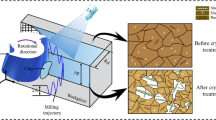Abstract
In this paper, by joining three non-traditional machining methods — plasma-enhanced machining, cryogenic machining, and ultrasonic vibration assisted machining — a new hybrid machining technique for machining of Inconel 718 is presented. Cryogenic machining reduces the temperature in the cutting zone, and therefore decrease tool wear and increases tool life, while plasma-enhanced machining helps to increase the temperature in the workpiece to make it softer. Also, applying ultrasonic vibrations to the tool helps to improve cutting quality and to prolong tool life by lowering, mainly, the cutting force and improving the dynamic cutting stability. This study experimentally investigates the effect of cutting parameters on cutting performance in the machining of Inconel 718 and compares the results of hybrid machining and conventional machining (CM). It is found that the hybrid method results in better surface finish and improves tool life in hard cutting at low cutting speeds as compared to the CM method.
Similar content being viewed by others
References
Balazinski M, Songmene V (1995) Improvement of tool life through variable feed milling of Inconel 600. Ann CIRP 44(1):55–58
Smithberg D (1987) Inconel 718 machining manual, Report 6M59-559. Manufacturing Research and Development, Boeing Commercial Airplane Company
Chen YC, Liao YS (2003) Study on wear mechanisms in drilling of Inconel 718 superalloy. J Mater Process Technol 140:269–273
Elwardany TI, Mohammed E, Elbestawi MA (1996) Cutting temperature of ceramic tools in high speed machining of difficult-to-cut materials. Int Mach Tools Manuf 36(5):611–634
Rahman M, Seah WKH, Teo TT (1997) The machinability of Inconel 718. J Mater Process Technol 63:199–204
Pentland W, Mehl C, Wennbery J (1960) Hot machining. Am Mach/Metalwork Manuf 1:117–132
Copley SM (1985) Laser applications. In: King RI (ed) Handbook of the high speed machining technology, Chapter 16. Chapman and Hall, Dordrecht
Komanduri R, Flom F, Lee M (1985) Highlights of the DARPA advanced machining research program. J Eng Ind Trans ASME 107:325–335
König W, Cronjager L, Spur G, Tonshoff H, Vigneau M, Zdeblick W (1990) Machining of new materials. Ann CIRP 39(2):673–681
Kitagawa T, Maedawa K, Kubo A (1998) Plasma hot machining for high hardness metals. Bull Jpn Soc Precis Eng 22(2):145–151
Wang ZY, Rajurkar KP, Fan J (1996) Turning Ti–6Al–4V alloy with cryogenic cooling. Trans NAMRI/SME 26:3–8
Dhar NR, Kamruzzaman M (2007) Cutting temperature, tool wear, surface roughness and dimensional deviation in turning AISI-4037 steel under cryogenic condition. Int J Mach Tools Manuf 47:754–759
Brehl DE, Dow TA (2008) Review of vibration-assisted machining. J Precis Eng 32:153–172
Babitsky VI, Kalashnikov AN, Meadows A, Wijesundara AAHP (2003) Ultrasonically assisted turning of aviation materials. J Mater Process Technol 132:157–167
Jin M, Murakawa M (2001) Development of a practical ultrasonic vibration cutting tool system. J Mater Process Technol 113:342–347
Kim JD, Choi IH (1997) Micro surface phenomenon of ductile cutting in the ultrasonic vibration cutting of optical plastics. J Mater Process Technol 68:89–981
Ma C, Shamoto E, Moriwaki T, Zhang Y, Wang L (2005) Suppression of burrs in turning with ultrasonic elliptical vibration cutting. Int J Mach Tools Manuf 45:1295–1300
Wang ZY, Rajurkar KP et al (2003) Hybrid machining of Inconel 718. Int J Mach Tools Manuf 43:1391–1396
Skelton RC (1969) Effect of ultrasonic vibration on the turning process. Int J Mach Tool Des Res 9:363–374
Zhou M, Wang XJ, Ngoi BKA, Gan JGK (2002) Brittle–ductile transition in the diamond cutting of glasses with the aid of ultrasonic vibration. J Mater Process Technol 121:243–251
Author information
Authors and Affiliations
Corresponding author
Rights and permissions
About this article
Cite this article
Feyzi, T., Safavi, S.M. Improving machinability of Inconel 718 with a new hybrid machining technique. Int J Adv Manuf Technol 66, 1025–1030 (2013). https://doi.org/10.1007/s00170-012-4386-7
Received:
Accepted:
Published:
Issue Date:
DOI: https://doi.org/10.1007/s00170-012-4386-7




